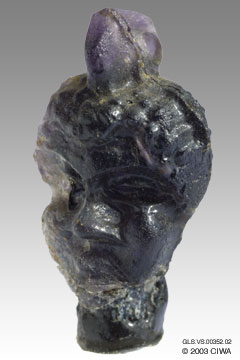Miniature head, Carthage, 400-300 BC.

Links to other views:⇒ Larger Viewif scripting is off, click the ⇒ instead. Links to others of type PendantBronze stauros (cross) pendant, CopticFaience amulet of Bastet, c. 750 BC. Gold pendant, Cyprus, 1400-1300 BC. Sin (crescent) pendant, Iran, 1200 BC |
This miniature head, a pendant cast from purple glass, depicts a black African, with tightly kinky hair and a smooth beard. Carthage, 400 - 300 BC. Parallels: “male Negroid head with curly locks of hair and smooth beard. Cagliari, Tuvixeddu necropolis” (Moscati 1988:482). “Glass: Maria Luisa Uberti says: The figure pendants discovered at Tharros are numerous and varied… The pendant types (including the examples from Tharros now in the British Museum and the Louvre) are as follows: demon head; male Negroid head with curly locks of hair and smooth beard; female human head with curly hair or hair wrapped in a headdress; two-faced monochrome female head with long tresses of wavy hair of the type found in Sicily and Ibiza (Tharros, Sulcis, Cagliary, Tuvixeddu necropolis)… One of the problems of Phoenician glass is always establishing when and from where glassware was imported. We must be cautious in attributing to local industry a craft which requires not only technical expertise (which can be brought by immigrant craftsmen) but also and more importantly specific equipment and raw materials combined in the correct proportions, areas in which we still have no information” (Moscati 1988:482-483). Bibliography (for this item)Moscati, Sabatino1988 The Phoenicians. Abbeville Press, New York, NY. (482-483) |